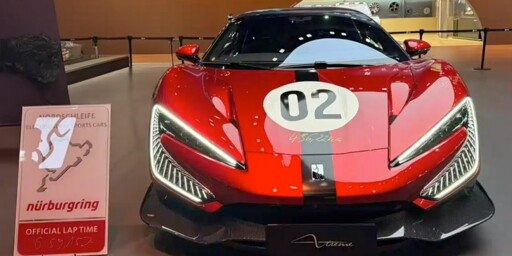Engineering explained made an interesting video pointing out how useless all this theoretical power ends to be:
He left out an important data point with all of his math. One he doesn’t have any data on. He failed to account for down force created by the vehicle. He completely ignored it. Downforce completely changes breakaway speeds on the tires.
As to why it gets slower times than a thousand hp car on the track, it’s simple. The car weighs MUCH more. Like 2,000 pounds more. That makes braking and turning and acceleration slower (but there’s plenty of power to overcome the acceleration) and like what he did touch on, the battery isn’t large enough to go “all out” on this track without running out of juice.
If the byd car could use magic to make it weigh as little as the zr1 and not be battery capacity limited, it would wipe the floor with the zr1.
So yes, 3,000hp and all wheel drive is a benefit. It just can’t overcome the weight difference through all the turns and deceleration on the track.
You are right in pointing this out, but I doubt it would change things much: the BYD car doesn’t seem to be that extreme in terms of downforce and if, for reference, an F1 car can generate around 1500kg of downforce at 200km/h, I wouldn’t expect more than some hundred kg on the EV. At a weight of 2500kg, it is a relevant but small percentage, only in fast sections of the circuit. On the flip side, they have to lift even more because of increased drag.
And generally regarding the weight: this is exactly the point, huge power at the cost of huge weight is a big trade off, even with the undersized battery they use. That’s why power/weight ratio is the thing to look for, but in this case physical limits are the ceiling against which the BYD bumps. It is nevertheless an extremely impressive car and pretty visionary.
That should be sufficient. 😋
Sufficient you say?

Wow, that’s insane. I mean insane that a 6.25 liter V8 only has about 200 hp in 1979!?
Didn’t the Americans make way more powerful production muscle cars at that time? I seem to recall an American road legal muscle car that could drive 350 km/h.American V8s suffered the same fate. The 1979 Mustang’s V8 was 4.2 liters for 120 hp. The Corvette had a 5.7 for 195 or 225 hp, depending on compression ratio.
It was the smog era- without leaded fuel, fuel injection, catalytic converters, and fully computerized ignition timing, you were stuck with 8.0:1 compression and worst-case-scenario timing and fuel ratio tunings.
The mustang got a proper power plant in 1985 and heralded the end of the malaise era
https://www.hagerty.com/media/archived/heavier-slower-safer/
Should be, but there’s always some Tim the Toolman type out there demanding “MOAR POWER!”
for some reason I read that in Jeremy Clarkson’s voice
Funnily enough (for his more power character) he went on Harry’s Garage recently and said that somewhere under 600hp (i think) is realistically plenty.
Yangwang
That can’t be real lol
The thing about horsepower like that is that its complelty useless for the task of moving people; speed is limited by human perception and response time, not something about the engine or car.
Going faster means having a controlled travel environment, like high speed rail
You’re assuming humans will be in control. We already have self-driving cars that are working well enough to expand into several additional markets, so surely combining that with vehicles that can get people where they want to be significantly faster can’t be all that far behind.
This is a vehicle that’s being made today, not some hypothetical future that has no pedestrians or other vehicles
It’s also one that’s only going to have 30 made, according to the article. Most of those are likely to only wind up sitting in billionaires’ garages for bragging rights. People do stupid shit for the chance to brag about it, and this company is talking advantage of that to gain in multiple ways: financial, reputation, experience, etc.
Big Wang for the little wang.
I hear you, but if these cars undercut and outperform Teslas at the same time, the prices should drop across the board for everyone. Cleaner roads are a win for everyone.
That’s only if the cheaper prices are legitimately possible while still bringing in a profit that’s worth mentioning. It’s well known that the Chinese government subsidizes a LOT of their companies, presumably hoping to put the established order out of business.
The American government subsidises American car manufacturers too though, no?
I couldn’t care less. I’ll take my 300bhp manual all day.
At the risk of being rude, that sounds somewhat obsolete by today’s standards, where you can have a 400hp+ EV for less than $30k.
https://www.bilbasen.dk/brugt/bil/polestar/2/performance-awd-5d/6690882This is even in Denmark, a country known for notoriously high car prices.
I guess manual means it’s ICE, and it probably has a lot of charm, and goes VROOM 😋 ,
So maybe more fun, but from a more pragmatic viewpoint, ICE is yesterdays news.
For an ICE 300hp is impressive, for an EV not so much.Nah, I think you’re missing their point.
One of the car memories that lives rent free in my head was having a ton of fun whipping a cheap rental on some winding back roads in Croatia and getting absolutely dusted by the old shitbox in front of us. We finally caught up to the dude at a traffic light and said “hey, we tried, but it’s only 100hp” and he said “that is more than enough, you just don’t know how to drive”.
Spot on.
Cool story 😎 And you are 100% correct in that nothing like that crossed my mind from reading that post.
And that’s despite living in Denmark a country with one of the most significant mountains in the world.
Sky mountain, which is the place the Norse Gods prefer as their stepping stone to the Rainbow bridge that leads to Asgard.
ThehillMOUNTAIN has the impressive height of ALMOST 150 meters!! Only 20 meters short of the highest point in Denmark.

So cool!!
I’m not trying to be cool. I just don’t care about absurd bhp. ICE or EV it’s just an absurd arms race.
For an EV a 600km range with real world driving is impressive, for an ICE vehicle not so much.
I’ll take charging the 400-500 km of that distance from home for free from my solar panels any day.
The longest distance we drive semi regularly is about 500 km.
In an ICE car that’s about 67 liter of gasoline for the round trip, which is now almost €2 per liter here. That’s €134 in gasoline per trip.
In the EV it’s 18kWh/100km making it 180 kWh total for the round trip, of which we start precharged with 77 kWh each way, only needing to charge 26 kWh.
Even with a very healthy safety margin charging 50 kWh, (10 minutes each way) We only spend about €20 on charging.The time it takes to charge matches the time it takes to step aside to pee, and is less time than getting a cup of coffee or a snack for the trip.
I can spend €100 on snacks on the trip, and still come out ahead economically. 😋
And the charging has not extended the time it takes significantly if at all.I live in Australia, some of my trips are 1200+ km in a day, add in charging time and it’s simply not realistic for me to use an EV. My longest trip is 2,200km in one go which already takes 25-26 hours including stops.
The lower cost is great but wouldn’t make up for needing to pay for an additional overnight stay. There’s also zero infrastructure for EVs in remote locations.
EVs aren’t quite there for everyone’s use cases. I would have one for around town… if they weren’t privacy nightmares.
That’s a very special case where EV is not suitable. The 2200 km in 26 hours you mention is very far from legal driving in most countries. Here you need resting periods, and AFAIK you can’t legally drive more than 11 hours per day as a professional, so that trip would take 2 days here anyway, unless it’s something you do for fun?
So here (EU) that trip would in fact be possible with an EV with little loss of time, because of the mandatory resting periods, but maybe in Australia there wouldn’t be the necessary infrastructure to charge on such long trips.Even here in little old England my commute to the office and back is 150 miles. These “300 mile range” EVs rarely actually do 300 miles so I’d need to charge my car up at home every day. If I forget then I’m stuck trying to find a supercharger in rush hour, which sounds like a recipe for disaster.
I have a neighbor that commute 300+ km round trip every day no problem for years. Driving from home fully charged he can get to Copenhagen and back on the same charge at 130 km/h almost all the way on “Motorway”.
Even with the extra distance you require, it should be easily possible if your place of work has a charger reserved for you.
Even a normal 11 kWh home charger is more than enough to get you going home fully charged in an 8 hour workday of charging.





